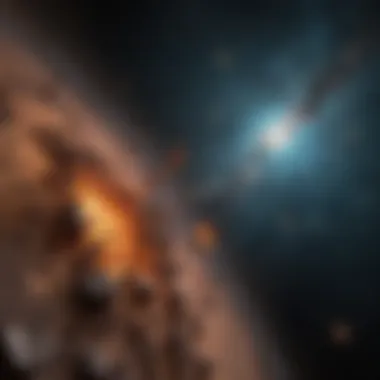The Current Status of the James Webb Space Telescope


Overview of Research Topic
Brief Background and Context
The James Webb Space Telescope (JWST) represents a significant advancement in astronomical technology. Launched on December 25, 2021, it succeeded the Hubble Space Telescope, providing enhanced capabilities for observing the universe in infrared. This allows for a more detailed analysis of celestial formations, the early universe, and the development of atmospheric conditions on exoplanets. JWST aims to address fundamental questions about the cosmos, including the formation of stars, galaxies, and planetary systems. The development of JWST involved an international collaboration of NASA, the European Space Agency (ESA), and the Canadian Space Agency (CSA).
Importance in Current Scientific Landscape
JWST is positioned at the forefront of modern astronomy. Its ability to capture data in multiple wavelengths opens new avenues for research. Findings from JWST not only extend our theoretical understanding but also present practical insights into the conditions necessary for life beyond Earth. Observations can have implications across a range of fields, including astrophysics, cosmology, and planetary science. Thus, the status and functions of JWST are crucial to ongoing scientific inquiry and exploration.
Methodology
Research Design and Approach
The operational status and impact of JWST are evaluated through a mixed-methods approach. This includes qualitative data from mission reports and quantitative data from the telescope's astronomical findings. A continuous assessment of its performance metrics ensures that it meets its mission objectives effectively.
Data Collection Techniques
JWST employs various data collection techniques that are integral to its mission. These include:
- Spectroscopy: Analyzing light from celestial bodies to determine their composition and dynamics.
- Imaging: Capturing high-resolution images to study distant galaxies and star systems.
- Photometry: Measuring the intensity of light from objects to study their physical properties.
By harnessing these techniques, JWST provides unprecedented insights into the universe, enhancing our comprehension of its structure and evolution.
Preface to the James Webb Space Telescope
The James Webb Space Telescope represents a paradigm shift in our ability to observe the cosmos. As a successor to the Hubble Space Telescope, its advanced capabilities enable it to capture images and data that were previously unattainable. This section explores the significance of the Webb telescope in advancing our understanding of the universe, its intricate design, and the extensive planning behind its development.
Overview of JWST
The James Webb Space Telescope is designed to delve into the mysteries of space, covering a wide range of astronomical domains. Unlike Hubble, which primarily observes in ultraviolet and visible light, JWST focuses on infrared wavelengths. This shift allows it to peer through cosmic dust and gas, revealing objects that are otherwise obscured. Moreover, its larger primary mirror, measuring 6.5 meters across, provides the telescope with the ability to gather more light than its predecessor. Consequently, the capabilities of JWST open a new era for astrophysical research, from studying the formation of stars and galaxies to examining the atmospheres of distant exoplanets.
The telescope's instruments include a Near Infrared Camera (NIRCam), a Mid-Infrared Instrument (MIRI), and a Near Infrared Spectrograph (NIRSpec), each contributing to its multifaceted mission.
Development and Launch Timeline
The journey of the James Webb Space Telescope has been an extensive and complex process. Initial conceptualization began in the late 1990s, driven by the need for a more powerful telescope to complement the existing space observations. After years of research, development, and numerous technical challenges, the launch was scheduled for 2021, a date that marked the culmination of decades of collaborative efforts among scientists and engineers from NASA, the European Space Agency, and the Canadian Space Agency.
However, the timeline was not without its setbacks. Originally planned for launch in 2007, the project faced multiple delays due to technical difficulties and budget overruns. The integration of sophisticated components, essential for its operation, posed challenges that required innovative solutions. Despite this, the monumental launch finally took place on December 25, 2021. The telescope successfully reached its designated orbit around the Sun, approximately 1.5 million kilometers from Earth, allowing it to begin its mission to uncover the secrets of the universe.
In summary, the development and launch history of JWST showcases both the ambition and resilience of the scientific community. It highlights the lengths to which researchers will go to seek knowledge about the cosmos and our place within it.
Mission Objectives of JWST
The James Webb Space Telescope (JWST) has distinct mission objectives that are crucial for pushing the boundaries of astrophysical knowledge. Understanding these objectives helps to contextualize JWST's broader impact on astronomy and related sciences. The goals are ambitious, addressing essential questions about our universe's origin, evolution, and the phenomena that govern celestial mechanics. JWST aims to answer fundamental queries about the lifecycle of stars, the formation of galaxies, and the conditions necessary for life beyond Earth.
Key Science Goals
JWST's mission is structured around several key science goals that set it apart from previous surveys and missions, such as the Hubble Space Telescope. These goals include:


- Studying the Early Universe: JWST seeks to observe the formations of the first galaxies and stars. This involves imaging high-redshift objects, which provides insights into the cosmic dawn, roughly 13.5 billion years ago.
- Exploring Stellar Formation and Evolution: Understanding how stars form and evolve is a primary objective. JWST's infrared capabilities make it possible to peer through dust clouds that often obscure these processes.
- Investigating Exoplanet Atmospheres: Another pivotal goal is to analyze the atmospheres of exoplanets. JWST can utilize spectroscopy to identify potential biosignatures and chemical compositions, contributing to our understanding of habitability.
- Studying Galaxy Formation and Dynamics: Observing galaxies across various stages helps reveal the dynamics of cosmic evolution. JWST can provide high-resolution images that detail the structures and interactions of galaxies.
These goals enrich our understanding of fundamental cosmic principles. They also bridge gaps between theoretical astrophysics and practical observation.
Comparative Analysis with Hubble
A direct comparison between JWST and the Hubble Space Telescope brings clarity to the significance of JWST's mission objectives. While Hubble revolutionized our view of the universe with its optical capabilities, JWST extends this vision into the infrared spectrum.
- Imaging and Spectroscopy: Hubble operates primarily in the optical and ultraviolet wavelengths. In contrast, JWST's advanced instruments are suited for infrared observations. This allows JWST to study cooler objects and events that Hubble may not effectively resolve.
- Resolution and Sensitivity: JWST promises greater resolution and sensitivity. This advancement enhances the ability to detect fainter objects, which is pivotal for studying the early universe, as light from distant galaxies becomes redshifted into infrared wavelengths.
- Discovery Potential: Hubble’s legacy includes iconic images of various celestial bodies. JWST aims to build upon this foundation by uncovering new worlds and phenomena that remain undetected. As a result, astronomers anticipate a wealth of data that could reshape our understanding of cosmic evolution.
"JWST is not just an extension of Hubble but an entirely new approach to space observation, designed for a new epoch in astronomical research."
In summary, the mission objectives of JWST are distinctly ambitious yet critically important. They are focused on answering essential questions about the universe and offering new opportunities for discovering phenomena that have yet to be observed. The contrast between JWST and Hubble emphasizes the importance of infrared exploration and sets the stage for a new era of astronomical understanding.
Operational Status and Performance
The operational status and performance of the James Webb Space Telescope (JWST) are critical in understanding its capabilities and contributions to astronomy. This section explores the integral elements of its operations, technical features, and the challenges faced post-launch. Each subsection provides insight into how the JWST is functioning in its mission to expand our knowledge of the cosmos.
Current Position and Operations
As of now, the JWST is positioned at the second Lagrange point (L2), about 1.5 million kilometers from Earth. This specific location allows for a stable environment, minimizing gravitational influences from the Earth and the Moon. The telescope's orbit enables continuous observation of the universe without the interruptions caused by terrestrial weather or the day-night cycle.
Operations of the JWST are managed by a team at the Space Telescope Science Institute, which oversees its scientific programs. The operations involve complex processes, such as orienting the telescope to observe selected targets and collecting data from the onboard instruments. The initial months post-launch were dedicated to instrument commissioning, ensuring that all systems functioned properly.
Technical Specifications and Features
The JWST is a remarkable feat of engineering, featuring advanced technology that distinguishes it from its predecessors. Some notable specifications include:
- Primary Mirror: The 6.5-meter diameter mirror is segmented into 18 hexagonal pieces. This large aperture enables observations in the infrared spectrum, which is essential for studying distant galaxies and star formation.
- Instruments: JWST is equipped with four main scientific instruments: the Near Infrared Camera (NIRCam), the Near Infrared Spectrograph (NIRSpec), the Mid-Infrared Instrument (MIRI), and the Fine Guidance Sensor/Near InfraRed Imager and Slitless Spectrograph (FGS/NIRISS). These tools allow for a range of observations.
- Sunshield: The telescope has a multi-layer sunshield the size of a tennis court to protect it from solar radiation and maintain its instruments at cryogenic temperatures.
These features enable JWST to conduct its mission objectives efficiently. The ability to observe in the infrared allows it to see through cosmic dust and gas, leading to significant discoveries about the universe.
Challenges Encountered Post-Launch
Despite successful deployment and operation, JWST has faced several technical challenges since its launch. Initially, the commissioning phase was complicated by issues such as:
- Mirror Alignment: During early operations, aligning the segmented mirror required precision adjustments. Completing this task successfully was crucial for optimal image quality.
- Software Bugs: During the operational setup, some software glitches hindered functions. These were addressed through remote updates and modifications by the team at the Space Telescope Science Institute.
- Environmental Factors: The environment at L2 poses unique challenges, including radiation exposure. Monitoring systems to ensure that the telescope remains functional in this environment is crucial.
Overall, the operational status of the JWST reflects its complexity and robustness as it pushes the boundaries of astronomical research.
Recent Discoveries and Research Developments
The James Webb Space Telescope (JWST) stands at the forefront of astronomical exploration, reshaping our understanding of the cosmos through its latest discoveries and contributions to research. Its advanced capabilities and state-of-the-art instrumentation allow it to capture images and spectra that deepen our insights into the universe. The findings from JWST are instrumental for students, researchers, educators, and professionals, as they present groundbreaking data that can influence future studies across multiple disciplines.
First Images and Spectra
JWST's debut in imaging has already delivered remarkable results. The telescope provides images with an unprecedented resolution and clarity. The first images unveiled vast star fields and details of distant galaxies, showcasing featuers that were previously impossible to discern. This clarity allows astronomers to analyze light spectra from these celestial objects, revealing their chemical compositions and physical properties.
By obtaining data across various frequencies, JWST enables scientists to conduct thorough analyses. This includes identifying elements like hydrogen, carbon, and water vapor, critical for understanding cosmic evolution and the potential for life beyond Earth. The detailed spectra open new pathways for researching the early universe, dark matter, and other phenomena.


"JWST’s sensitivity allows it to detect the faintest signals from the earliest galaxies, providing a window back into time.”
Insights into Exoplanets
JWST has revolutionized the study of exoplanets, those planets outside our solar system. The ability to observe their atmospheres is a milestone. Utilizing transit spectroscopy, JWST studies the light that filters through the atmospheres of these distant worlds as they pass in front of their host stars. The data collected here is illuminating.
Scientists are discovering vital details about exoplanet atmospheres, including the presence of clouds, haze, and even potential signs of habitability. Understanding these atmospheric compositions enriches debates around the likelihood of life elsewhere in the universe. Moreover, the insights gained from exoplanet studies help refine our models related to planet formation and the conditions that foster life.
Age-Old Galaxies and Stellar Evolution
The study of ancient galaxies has always intrigued astronomers. JWST provides the tools necessary to observe distant galaxies, some of which formed shortly after the Big Bang. These observations enable a deeper understanding of galaxy formation and evolution over billions of years.
JWST delves into how stars within these galaxies evolve. By examining light from various stages of stellar life cycles, researchers gather information on the formation of stars, supernovae, and the recycling of stellar material. These processes are pivotal to understanding how galaxies develop over time and their role in the broader cosmos.
Interdisciplinary Impact of JWST
The James Webb Space Telescope plays a pivotal role in advancing our understanding of the universe. It does not just contribute to a single field; its impact stretches across diverse disciplines within the sciences and even beyond. This interdisciplinary influence is significant for numerous reasons, as it promotes collaboration and expands the boundaries of knowledge across various fields, such as cosmology, astrobiology, and planetary sciences.
Advancements in Cosmology
One of the primary areas benefitting from JWST's observations is cosmology. The telescope's capacity for deep-space imaging allows scientists to investigate the formation and evolution of galaxies. JWST observes galaxies that are billions of light-years away, providing a window into the early stages of the universe.
- By focusing on high-redshift phenomena, JWST helps determine the rate of cosmic expansion.
- Researchers can analyze the formation of the first stars and galaxies, which occurred within the first few hundred million years after the Big Bang.
This data can elucidate the nature of dark matter and dark energy, both fundamental components of the universe's structure. The ability to probe beyond what has previously been possible makes JWST an instrumental tool in addressing some long-standing cosmological questions.
Influence on Astrobiology Research
Astrobiology is another domain that stands to gain significant insights from JWST's data. The telescope's technology allows it to analyze the atmospheres of exoplanets, a feat that is crucial for understanding potential habitability.
- JWST is equipped with spectroscopic instruments that can detect chemical signatures of life or prebiotic conditions in the atmospheres of distant worlds.
- Observations can reveal the presence of water vapor, carbon dioxide, and other molecules that are essential for life as we know it.
This information opens new discussions about the formation of life in varying environments across the universe. The collaboration between astrobiologists and cosmologists, facilitated by JWST’s findings, emphasizes a holistic understanding of the cosmos.
"The James Webb Space Telescope is not just a tool for exploring space; it is a bridge across scientific disciplines, connecting cosmology and astrobiology in unprecedented ways."
In summary, the interdisciplinary impact of JWST significantly enriches our exploration and comprehension of the universe. By facilitating cooperation between different scientific fields, JWST fosters advancements that could redefine our place in the cosmos.
Collaboration and Data Sharing
The collaboration and data sharing aspect of the James Webb Space Telescope (JWST) is crucial for enhancing scientific understanding across multiple disciplines. The complexity and scale of the data produced by JWST requires an integrated approach that involves many institutions and researchers globally. This collaborative effort not only amplifies the reach of the findings but also enriches the scientific community's collective knowledge base.
Open sharing of data enables various groups to analyze, interpret and build upon the work done by others. The accessibility of JWST’s data is expected to catalyze new discoveries and insights, fostering an environment of continuous learning and verification among scientists. The importance of data sharing lies in its power to democratize knowledge, allowing researchers who may lack access to expensive facilities to engage with cutting-edge data and technology.
Moreover, collaboration extends beyond just academic institutions. By involving a wider range of organizations, including governmental agencies, space agencies, and private entities, JWST's impact can be maximized. With this joint effort, the scientific community not only progresses in answering existing questions but also formulates new hypotheses based on shared insights. In essence, collaboration and data sharing are potent tools in realizing the full potential of JWST's mission objectives.
Partnerships with Global Institutions
The partnerships formed with global institutions are foundational to the operational success of JWST. This telescope is the result of collaboration primarily between NASA, the European Space Agency (ESA), and the Canadian Space Agency (CSA). Each partnering entity brings unique strengths and capabilities, creating a multifaceted approach toward astronomical research.


For instance, while NASA handles overall mission management and operations, ESA contributes through instruments and components like the Ariane 5 launch vehicle. Meanwhile, CSA's participation illuminates the telescope’s capabilities. Such diverse expertise allows JWST to leverage a wide array of technologies and knowledge, fostering innovation that individual organizations might not achieve alone.
These partnerships have allowed for the establishing of a centralized science team that works across borders. By strategically sharing resources, the scientific output from JWST gets enhanced. Projects benefit from shared funding, reduced operational costs, and shared intellectual resources, creating a profound synergistic effect.
Public Access to Data
One of the key features of JWST is the commitment to public access to its data. This openness is a significant advantage as it enables further analysis and usage by any interested party, which includes academic researchers, students, and independent scientists. The policy of making data freely available aligns with the broader philosophical trend towards open science.
Data from JWST becomes available 12 months after it is collected, allowing institutional teams to first publish their findings. This approach balances the need for leading scientists to analyze their results while still providing an opportunity for wider engagement by the community. It promotes transparency, which is essential for validation and reproducibility in scientific work.
The implications of public access are vast. An active public database invites a multitude of interpretations and applications. Amateur astronomers, educators, and scientists can explore the data, leading to potentially unforeseen discoveries or educational opportunities. By democratizing access to scientific data, JWST empowers a broader audience and enhances the telescope’s influence and relevance in the scientific dialogue.
"Collaboration and data sharing pave the way for new possibilities in scientific discovery, allowing knowledge to traverse boundaries."
Future Prospects and Expectations
The future of the James Webb Space Telescope (JWST) is pivotal in understanding how it can further enhance astronomical research. As we delve into its potential, we identify key elements that could expand our knowledge of the cosmos. These future prospects are not just about technology advancements but also cover scientific expectations and the broader implications of JWST's discoveries.
Upcoming Missions and Upgrades
With JWST firmly operational, scientists are already considering future missions and necessary upgrades. Several upcoming missions aim to refine the telescope's capabilities further. These include:
- Software Enhancements: As new algorithms evolve, the JWST software will need updates to maximize observational data's quality and usability.
- Instrument Upgrades: New instruments could potentially boost the spectral resolution or sensitivity of current sensors. This can lead to even deeper insights into distant celestial bodies.
- Extended Operational Lifespan: Mechanical and systems upgrades will be essential to support the operational lifespan beyond the original expectations, aiming for continuous scientific output for another decade or more.
These upgrades and missions aim to make JWST an even more powerful tool in the astronomical toolkit, providing researchers with rich data over time.
Long-Term Scientific Goals
The overarching scientific goals for the JWST extend well beyond its immediate discoveries. These long-term objectives include:
- Understanding Cosmic History: The JWST will tackle fundamental questions about the universe's formation and evolution, aiding in the understanding of events ranging from the Big Bang to star formation epochs.
- Characterizing Exoplanet Atmospheres: One of JWST's goals is to analyze the atmospheres of exoplanets. This research could reveal the conditions for life and the chemical compositions necessary for habitability.
- Studying Galaxy Formation: Researchers aim to trace the formation and evolution of galaxies across cosmic time, providing insights into dark matter, galaxy interactions, and their role in structure formation in the universe.
These scientific goals underscore the anticipation surrounding JWST's future role. As advanced as its current operations may be, its contributions could reshape our understanding of space fundamentally.
"The James Webb Space Telescope serves as a powerful reminder of human ingenuity, transforming our understanding of the universe as it continually pushes the boundaries of what we know."
JWST is not merely a technological marvel; it signifies the relentless quest for knowledge that embodies the essence of scientific discovery. As expectations build, both the astronomical and academic communities look forward to the continuous evolution of research propelled by JWST.
The End
The conclusion serves as a vital component of this article, encapsulating the essence of the James Webb Space Telescope's (JWST) contributions to modern astronomy. It not only summarizes the key findings and insights presented throughout but also emphasizes the lasting significance of the work done by this state-of-the-art instrument.
Summary of JWST's Impact
The JWST has radically transformed our understanding of the heavens. Its advanced capabilities allow scientists to peer deeper into the universe than ever before. This has resulted in groundbreaking discoveries, particularly in the fields of cosmology and exoplanet research.
- Enhanced Observational Power: The telescope's ability to observe infrared wavelengths opens new possibilities for studying celestial objects obscured by dust. Looking back in time to observe the early universe is now a tangible reality.
- Scientific Collaborations: The international partnerships established for the telescope's operation have created a holistic approach to space research. Institutions like NASA, ESA, and the Canadian Space Agency work together, providing a diverse range of perspectives and expertise.
Overall, JWST stands as a beacon of human ingenuity, paving the way for subsequent research and exploration.
Reflection on the Future of Astronomy
The future of astronomy appears bright with the integration of findings from the JWST. Researchers speculate about the complex questions the telescope could help answer.
- Continued Discoveries: The JWST is expected to refine or redefine our understanding of the cosmic phenomena, unlocking secrets of galaxy formation and evolution that remain unanswered.
- Interstellar Implications: Its findings will likely fuel advancements in related scientific fields, such as astrobiology. Understanding the conditions necessary for life is now within reach.
As we reflect on what lies ahead, it is clear that the JWST will play a crucial role in guiding the next chapters of astronomical study. The implications of its discoveries not only resonate within the field of astronomy itself but also inspire broader philosophical discussions about our place in the universe.



